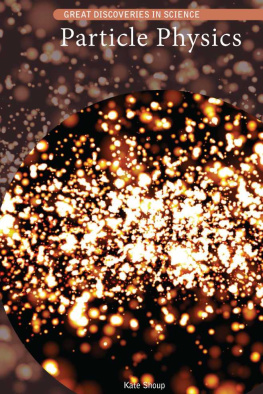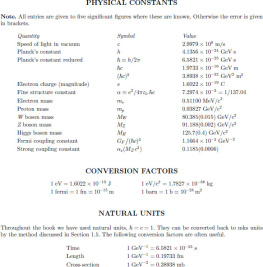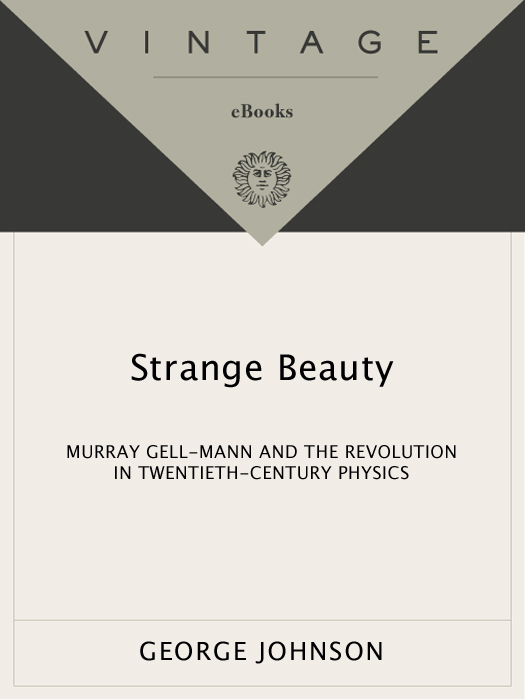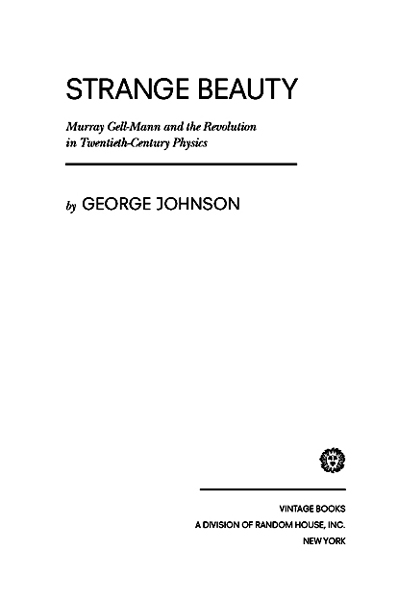Acclaim for George Johnsons
STRANGE BEAUTY
If biography were diving, the brilliant and irascible Murray Gell-Mann (alive!) would have to be something like a reverse 3 somersault half-twist from the pike position. George Johnson has nailed this one. Strange Beauty is complex, mind-expanding, beautiful, and true.
James Gleick
Brings together an irresistible subjectthe difficult polymath Murray Gell-Mannand a talented writer who spins an enthralling tale out of the kind of esoteric physics that generally flies right over our heads. Johnson is one of the best science journalists writing today. This is his most ambitious project yetcommunicating the fascination of a kind of science that only an elite of superbright people fully understands. He succeeds brilliantly.
Chet Raymo, Scientific American
We gain a front-row seat at an exhilarating intellectual demonstration. The elegance of Johnsons writing matches the beauty of Gell-Manns discoveries.
Marcia Bartusiak, The Washington Post Book World
A masterpiece of scientific explication for the layman. Science writing doesnt get much better than this
Phillip Anderson, Times Higher Education Supplement
Dramatic and lucid a joy to read.
Simon Singh, Daily Telegraph
Few physicists have displayed the poetic inspiration of the Nobelist Murray Gell-Mann. In this biography he emerges as brilliant and often insufferable, relentlessly curious, hopelessly pedantic, and one of the best synthetic thinkers in the history of his field.
The New Yorker
[Johnson] does a masterly job of making the arcana of particle physics available and shepherding the reader through increasing layers of complexity.
Kathleen Stein, The New York Times
Johnson makes no attempt to hide Gell-Manns relentless insecurity, debilitating perfectionism and abrasive manner. He appears as a flawed, almost Shakespearean hero in an era when prominent physicists like Einstein, Richard Feynman and Stephen Hawking are typically portrayed as comic-book heroes. Gell-Mann could not have written such a perceptive book about himself.
Louis A. Bloomfield, The New York Times Book Review
[Johnson] describes, convincingly, the life of a tormented genius and polymath, and his struggles with doubts, colleagues and perceived enemies. An outstanding book.
Chris Llewellyn Smith, The Times (London)
A fascinating, skillfully composed, and entertaining biography.
Gregg Easterbrook, Wilson Quarterly
An altogether impressive performance. I dont envy Murray the weird experience of reading so penetrating and perceptive a biography of himself. What a story! George Johnson has written a fine biography of this important and complex man.
David L. Goodstein, Engineering & Science (Caltech)
A riveting read for anybody interested in the history and sociology of late-twentieth-century science.
Nature
Johnson, an award-winning science writer, paints a fascinating portrait of this brilliant, complicated, sometimes insecure and often exasperating man.
Marcus Chown, New Scientist

George Johnson
Strange Beauty
George Johnson is a former Alicia Patterson Fellow and finalist for the Rhne-Poulenc Prize. His work for The New York Times received the 1999 Science Journalism Award from the American Association for the Advancement of Science. His previous books include Machinery of the Mind: Inside the New Science of Artificial Intelligence. In the Palaces of Memory: How We Build the Worlds Inside Our Heads, and Fire in the Mind: Science, Faith, and the Search for Order. He lives with his wife in Santa Fe, New Mexico, and can be reached through the Web at talaya.net.
ALSO BY GEORGE JOHNSON
Fire in the Mind: Science, Faith, and the Search for Order
In the Palaces of Memory: How We Build the Worlds Inside Our Heads
Machinery of the Mind: Inside the New Science of Artificial Intelligence
Architects of Fear: Conspiracy Theories and Paranoia in American Politics
FIRST VINTAGE BOOKS EDITION, OCTOBER 2000
Copyright 1999 by George Johnson
All rights reserved under International and Pan-American Copyright Conventions. Published in the United States of America by Vintage Books, a division of Random House, Inc., New York, and simultaneously in Canada by Random House of Canada Limited, Toronto. Originally published in hardcover in the United States by Alfred A. Knopf, a division of Random House, Inc., New York, in 1999.
Vintage Books and colophon are registered trademarks of Random House, Inc.
Grateful acknowledgment is made to the following for permission to reprint previously published material: Harold P. Furth: Perils of Modern Living by Harold P. Furth. Originally published in The New Yorker in 1956. Reprinted by permission of the author.
Alfred A. Knopf: Cosmic Gall, from Collected Poems 19531993 by John Updike, copyright 1993 by John Updike. Reprinted by permission of Alfred A. Knopf, a division of Random House, Inc.
The Library of Congress has cataloged the Knopf edition as follows:
Johnson, George.
Strange beauty: Murray Gell-Mann and the revolution in twentieth-century physics / by George Johnson. 1st ed.
p. cm.
eISBN: 978-0-307-76545-1
1. Gell-Mann, Murray. 2. Nuclear physicists
United StatesBiography. I. Title.
QC774.G45J65 1999
530.092dc21 [B] 99-19952
Author photograph Jerry Bauer
Diagrams by Arlene Lee
www.vintagebooks.com
v3.1
For Nancy
There is no excellent beauty that hath not some strangeness in the proportion.
Francis Bacon
(Quoted by Murray Gell-Mann in an article explaining his theory of cosmic-ray particles whose behavior seemed to defy the laws of physics)
In our work we are always between Scylla and Charybdis; we may fail to abstract enough, and miss important physics, or we may abstract too much and end up with fictitious objects in our models turning into real monsters that devour us.
Murray Gell-Mann, in a 1972 lecture on quarks in Schladming, Austria
CONTENTS
PROLOGUE
ON THE TRAIL
TO LA VEGA
I t was Memorial Day weekend of 1996, in the middle of what turned out to be one of New Mexicos worst droughts of the century. The seemingly endless dry spell reminded many of the climatic disaster said to have driven the Anasazi, the original inhabitants of this land, from their stone settlements around Mesa Verde, causing the collapse of a civilization. To escape the heat, I left my house in Santa Fe and drove as high as you can go into the nearby Sangre de Cristo Mountains. After leaving my Jeep in the ski basin parking lot, already some 10,000 feet above sea level, I began walking higher. My destination, La Vega, the meadow, lay at the base of Santa Fe Baldy, an 11,600-foot peak of Precambrian granite that juts above the timberline.
Almost as soon as I reached the trail head, I realized that, once again, I had misjudged the perversity of New Mexico weather. Looking out across the Rio Grande Valley, I could see the next mountain range, the Jemez, where just weeks earlier a fire had devastated fifteen thousand acres of one of my favorite places, the wilderness backcountry of Bandelier National Monument. Now storm clouds were boiling up over the Jemez and sweeping toward the Sangre de Cristos. The temperature began dropping, and before long snow flurries, of all things, were swirling around me.










